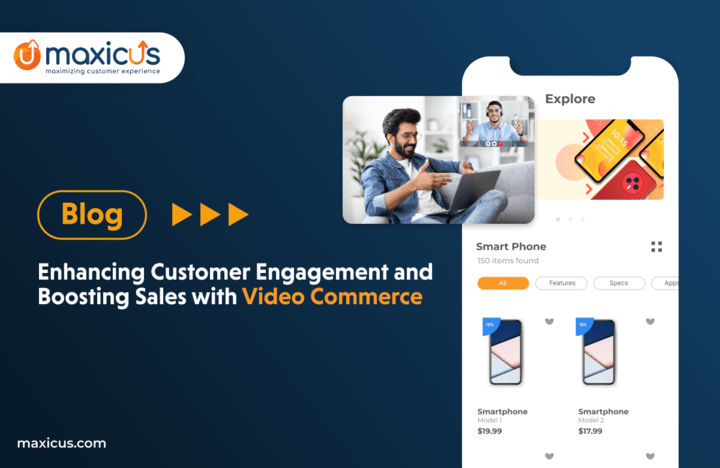Enhancing Customer Engagement and Boosting Sales with Video Commerce: Navigating the Future of Digital Interaction
In the rapidly evolving digital marketplace, businesses are constantly seeking innovative ways to engage customers and drive sales. One of the most transformative developments in recent years is the rise of video commerce. This approach leverages live, interactive video to create a more immersive and engaging shopping experience, combining the best of online convenience with the personal touch of in-person interactions. Let’s delve deeper into how video commerce is reshaping customer engagement and boosting sales, and explore the emerging concept of the “phygital” experience, which blends physical and digital interactions.
Understanding Video Commerce
Video commerce represents a significant shift from traditional e-commerce and digital marketing. Unlike static online product listings or pre-recorded promotional videos, video commerce involves real-time, interactive video experiences. This can include live product demonstrations, virtual consultations, and interactive Q&A sessions. By merging video content with real-time engagement, video commerce offers a more dynamic and personalized shopping experience.
The Evolution of Customer Expectations
To fully appreciate the impact of video commerce, it’s essential to understand how customer expectations have evolved. In an era where consumers have access to endless online content, the demand for personalized and engaging experiences has never been higher. Customers are no longer satisfied with passive browsing; they want interactive and immersive experiences that mimic the engagement of in-store shopping.
Traditional e-commerce has often struggled to replicate the sensory experience of physical retail. While online stores provide convenience, they lack the tactile and visual reassurance that comes from seeing and handling a product in person. Video commerce bridges this gap by offering real-time, interactive demonstrations that allow customers to experience products more comprehensively.
Key Benefits of Video Commerce
- Enhanced Product Visibility and Understanding
One of the primary advantages of video commerce is its ability to showcase products in a detailed and engaging manner. Live video demonstrations provide a clear view of product features, functionality, and benefits. This can be particularly valuable for complex or high-involvement products where customers may have numerous questions. For instance, a customer considering a high-end electronics purchase can see a live demo of the product’s capabilities and ask questions in real time, leading to a more informed purchase decision.
- Personalized Customer Interactions
Video commerce allows for a high level of personalization that traditional e-commerce methods often lack. During live video sessions, sales representatives can tailor their presentations to the specific needs and interests of individual customers. This level of customization can be achieved by analyzing customer data and behavior before the call, allowing sales teams to focus on relevant product features and benefits. For example, if a customer has expressed interest in a particular feature of a product, the representative can highlight that feature during the live demonstration.
- Real-Time Engagement and Feedback
The interactive nature of video commerce fosters real-time engagement between customers and brands. Unlike pre-recorded videos, live sessions allow customers to ask questions, provide feedback, and receive immediate responses. This interaction not only enhances the customer experience but also helps build trust and credibility. Customers appreciate the opportunity to engage directly with a brand representative and feel more confident in their purchase decisions when they can get their questions answered on the spot.
- Building Stronger Customer Relationships
Video commerce has the potential to strengthen customer relationships by creating a more personal and engaging experience. By interacting with customers in real time and addressing their specific needs, businesses can foster a sense of connection and loyalty. This personalized approach can lead to increased customer satisfaction, repeat business, and positive word-of-mouth referrals. For example, a customer who receives personalized recommendations and attentive service during a video call is more likely to return for future purchases.
- Increasing Customer Lifetime Value (C-LTV)
Video commerce not only boosts immediate sales but also increases customer lifetime value (C-LTV). By providing personalized and engaging shopping experiences, businesses can enhance customer loyalty and encourage repeat purchases. The interactive and real-time nature of video commerce helps build a stronger relationship between the brand and the customer, leading to higher customer retention and long-term profitability.
- Leveraging Data Insights
Many video commerce platforms provide valuable data insights that can inform marketing and sales strategies. By analyzing customer interactions, preferences, and feedback during video sessions, businesses can gain a deeper understanding of their audience and refine their approach to better meet their needs. This data can be used to tailor future video content, optimize sales strategies, and improve overall customer engagement. For instance, if data reveals that certain product features are frequently discussed during video calls, businesses can focus on highlighting those features in their marketing efforts.
Implementing Video Commerce in Your Business
Integrating video commerce into your business strategy involves several key steps:
- Choose the Right Platform: Selecting the appropriate video commerce platform is crucial for success. Look for platforms that offer robust features such as live video streaming, interactive chat, and integration with your existing e-commerce systems. Consider factors such as ease of use, scalability, and support for various devices and browsers.
- Train Your Team: To maximize the benefits of video commerce, ensure that your sales and customer service teams are well-trained in using the platform and conducting effective live video sessions. Training should cover technical aspects, as well as best practices for engaging with customers and handling live interactions.
- Create Engaging Content: Develop content that is relevant, informative, and engaging for your target audience. Plan live video sessions that address common customer questions, showcase product features, and provide valuable insights. Consider incorporating interactive elements such as polls, quizzes, and live demonstrations to enhance the experience.
- Promote Your Video Commerce Offering: To drive traffic and engagement, promote your video commerce offering through various channels. Utilize email marketing, social media, and your website to inform customers about upcoming live sessions and encourage participation. Highlight the benefits of video commerce and how it can enhance their shopping experience.
- Measure and Optimize: Continuously monitor the performance of your video commerce initiatives and gather feedback from customers. Use data insights to identify areas for improvement and optimize your approach. Regularly review key metrics such as engagement rates, conversion rates, and customer satisfaction to gauge the effectiveness of your video commerce efforts.
The Future of Video Commerce and the Phygital Experience
As digital technology continues to advance, video commerce is likely to become an increasingly central component of the e-commerce landscape. Innovations such as augmented reality (AR) and virtual reality (VR) may further enhance the video commerce experience by providing even more immersive and interactive elements. Additionally, as consumer expectations continue to evolve, businesses will need to stay agile and adapt their strategies to meet new demands.
An emerging trend that complements video commerce is the “phygital” experience, which blends physical and digital interactions to create seamless, omnichannel customer journeys. By integrating video commerce with in-store experiences, businesses can offer customers the best of both worlds. For example, a customer might attend a virtual product demonstration online and then visit a physical store to see the product in person or vice versa. This integrated approach can enhance customer satisfaction by providing more touchpoints and flexibility in how they interact with the brand.
Conclusion
In conclusion, video commerce represents a powerful tool for enhancing customer engagement and boosting sales. By combining real-time interactions with personalized experiences, businesses can create a more dynamic and compelling shopping journey. As technology advances and customer expectations shift, video commerce will play a crucial role in shaping the future of digital interactions. Maxicus, one of India’s leading phygital and video commerce providers, is well-positioned to help businesses embrace this innovative approach. Leveraging Maxicus’s capabilities offers a unique opportunity to stand out in a crowded marketplace and build lasting relationships with customers.
The phygital experience further enhances this by integrating physical and digital touchpoints, ensuring that customers receive a seamless and engaging experience regardless of how they choose to interact with the brand. By adopting both video commerce and phygital strategies, businesses can stay ahead of the curve and meet the evolving needs of their customers.










